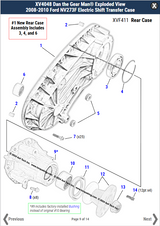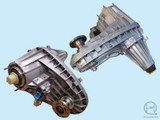How To Change Differential Fluid in Vehicles With Solid Beam Axles
How To Change Differential Fluid in Vehicles With Solid Beam Axles
February 3, 2021
While it's relatively easy to change differential fluid in vehicles with independent suspension drive axles, those with solid beam axles require a bit more expertise. While the basic idea is the same, the Monobeam Axle design has a few more quirks that you'll need to be aware of before hitting the garage. Figuring out how to change differential fluid in a vehicle with a solid beam type drive axle just requires some extra finesse and knowledge. But, with the proper amount of preparation, you'll be able to do a differential fluid change the right way to keep your vehicle running and hauling like it should.
What Is Differential Fluid and Why Do You Need To Change It?
Technically, the differential is one part of the axle, but the terms are often used interchangeably in the popular lexicon. Differential fluid is a type of oil (it's also called gear oil) that lubricates your vehicle's front and rear axles, specifically their gears, bearings and various internal components. The differential fluid helps the axles handle all of the pressure they must bear from torque.
Over time, all differential fluid will lose the qualities that provide necessary lubrication. This includes additives, detergents, demulsifiers and other chemicals, all of which are necessary for proper performance. Doing a differential fluid change regularly ensures that these components will not degrade to the point of harming your solid beam axles.
What Is a Solid Beam Axle and How Is It Different?
A solid beam axle is part of a dependent suspension system, meaning the wheels are linked together by a single, lateral beam and do not move independently. This differs from an independent suspension system wherein each wheel can move vertically on its own while connected to the same axle. The differences in construction mean that there are also differences in learning how to add differential fluid to them.
Additional Considerations for Changing Differential Fluid
Be aware of the following factors as you learn how to change differential fluid in solid beam axle vehicles:
- Although changing differential fluid for independent suspension systems can be done by novices, doing so for most solid beam drive axle designs requires time, patience and expertise.
- Change your differential fluid on the manufacturer-recommended schedule, often every 30,000 to 60,000 miles; the heavier the loads you haul, the shorter that interval should be.
- Used differential fluid has a foul, sulfuric smell, meaning proper ventilation is essential.
- Wear nitrile or rubber gloves for safety.
- Hardly any beam type axles have a drain plug, so you have two choices to change the fluid. The preferred method, and the one most professional use, is to remove the differential cover which allows for a complete fluid change, plus cleaning and inspection of the gears. The other method, which is typically done by fast change lube locations, is to suck out most of the fluid through the fill hole with a suction gun. Both methods have advantages and disadvantages. To remove, clean and replace the cover is more difficult and time consuming, but when done properly, it will get the 5%-10% of the fluid that can’t be sucked out through the fill hole, plus it allows you to inspect the gears for wear. Sucking out the fluid with a suction gun is quicker and easier, but typically the suction gun will leave up to 10% of the old fluid in the housing. Use the method that best works for your situation — either method will accomplish the goal of getting your dirty, old axle fluid replaced with new.
How To Change Differential Fluid on a Monobeam Axle
Although different makes and models may necessitate additional steps, doing a quick differential fluid change in a vehicle with a solid beam axle design generally requires the following:
- Park, stabilize and elevate the vehicle.
- Remove the used differential fluid by sucking it through the fill hole with a hose hand pump — for a complete replacement, remove the cover (but account for more time and effort to do so).
- Put in fresh differential fluid that meets the lubricant specifications set by your vehicle's manufacturer. (Consult your owner's manual.)
- Secure and replace any components you removed.
- Lower the vehicle.
- Drive around the block.
- Check for leaks and recheck the differential fluid level.
- Dispose of the old fluid appropriately and responsibly.
Get Differential Fluid for Your Vehicle Now at Torque King
You've learned how to change differential fluid in a vehicle with a solid beam type axle, but you still need the right fresh fluid to get the job done. Not to mention, you need the best differential fluid at a reasonable price. Torque King has you covered. Check out all the lubricants we offer to keep your solid beam axle truck or 4x4 running properly.
Latest News
New Ford NV273F Transfer Case Exploded Views - Shop the FAST and EASY way!
New, Easy-to-Use, Interactive Ford Super Duty and Excursion Transfer Cases Exploded Views are connec...
New Exploded View for 2018-Current Mahindra Roxor Transfer Cases!
New, Easy-to-Use, Interactive XV4060 Exploded View by Dan the Gear Man® for 2018-Current Mahindra...
NV5000 Manual Transmission Assembly for Dodge Ram 4x4s - Direct Replacement for NV4500HD
Available September 2024! A Direct Replacement for the NV4500HD - Upgrade today to the all new, c...
2003-2012 Ram NV271D Transfer Case Fluid and Torque Specifications, plus Recommended Mainteinance Schedule
The New Venture NV271D Manual Shift Transfer Case was the base transfer case for 2003-2012 Dodge and...
New Exploded View for 2003-2012.5 Dodge Ram Manual Shift NV271D Transfer Cases!
New, Easy-to-Use, Interactive XV4033 Exploded View by Dan the Gear Man® for 2003-2012.5 Dodge...
New Tools, Parts, Exploded Views, CAD Drawings, and Videos added in January 2023
We have added a number of new tools, parts, Exploded Views, CAD drawings, and videos to our websi...






